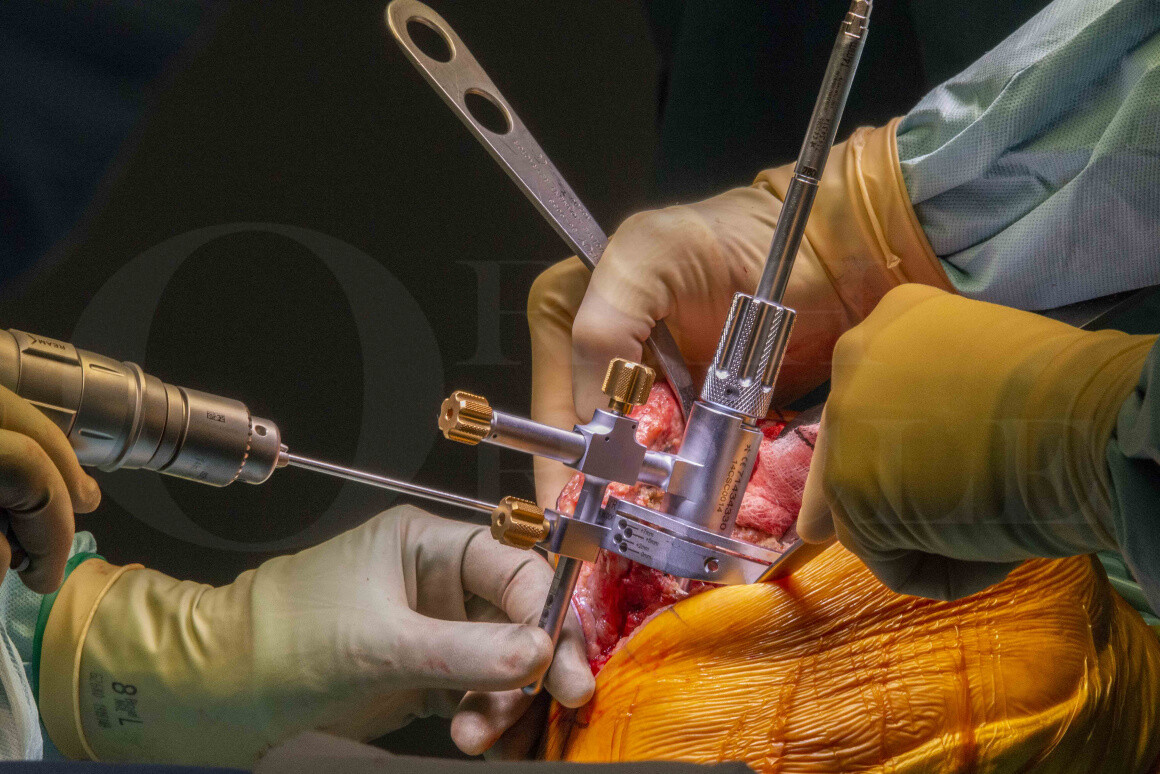Revision Total Knee replacement (Tibia only): Smith and Nephew Legion revision knee system and Implantcast Epore tibial cone
Overview

Subscribe to get full access to this operation and the extensive Knee Surgery Atlas.
Professional Guidelines Included
Learn the Revision Total Knee replacement (Tibia only): Smith and Nephew Legion revision knee system and Implantcast Epore tibial cone surgical technique with step by step instructions on OrthOracle. Our e-learning platform contains high resolution images and a certified CME of the Revision Total Knee replacement (Tibia only): Smith and Nephew Legion revision knee system and Implantcast Epore tibial cone surgical procedure.
This case demonstrates early aseptic failure and subsidence of the tibial component in a previously revised knee replacement. The patient functioned well for 12 months and then developed worsening shin pain. Radiographs demonstrated the tibial construct shifting into varus and new radiographic lucency under the tibial base plate. Infection has to be high on the differential diagnosis, particularly with early failure, but was excluded with normal inflammatory markers and a negative image guided biopsy. In our unit microbiological samples are sent for culture and sensitivity, and fluid samples are analysed for total white cell count and neutrophil percentage.
In this case a single component revision is performed, leaving the well fixed stemmed femoral component. This is an uncommon scenario as the majority of revisions for aseptic loosening involve both components. It is likely the tibial stem was undersized at the previous operation resulting in inadequate fixation. The more usual scenario of revising both components also allows the surgeon more flexibility in creating a balanced, stable TKR with restoration of the joint line.
A single component revision (particularly of a previous revision implant) is technically challenging and exposing the tibia adequately is key. The advantages of a single component revision including preservation of bone stock and avoiding the need for a hinged implant, shorter operative time and lower morbidity. It is essential the knee is not unstable beforehand, or at least symmetrically tight or loose in both flexion and extension. Revising the tibia only reduces the intra-operative balancing options and adjustments will affect both flexion and extension. Meticulous care must be taken not to damage the femoral component, which could accelerate wear in the medium term.
The Legion revision knee system from Smith and Nephew is a flexible revision knee reconstruction system which allows the surgeon options of cemented or hybrid fixation with uncemented stems, offsets from 2 to 6 mm and a cone system to reconstruct zone 2 defects. There is an easy conversion to the Legion Hinge if needed (see both Legion constrained knee and hinge TKR elsewhere).
Cones or sleeves are increasingly used in revision knee surgery. In this case a tibial cone from Implantcast was used to both manage the tibial bone loss and augment fixation of the tibial construct.
Cones are inserted independent of the prosthesis being used and are based on guided milling to increase implant stability and apposition of the cone to available host bone. Tibial shapes are often triangular to optimise endosteal contact. They are porous, with a Young’s modulus similar to bone, and have a high coefficient of friction allowing a press fit with initial mechanical stability and structural support. Femoral cones are usually based on a bilobed design that allows the lobes to bottom out at the junction of the metaphysis and diaphysis. The implant stem is inserted through the cone and the interface reinforced with cement.
Sleeves are a commonly used alternative to cones. They differ in that they have an implant specific tapered junction that attaches to the tibial tray. They have a longer history and heritage and may transfer more load to the metaphysis due to their design. They are however less useful in larger defects.
OrthOracle readers will also find the following related instructional operative techniques of interest:
Total knee replacement: First stage revision with a hinged spacer and tibial tubercle osteotomy
Revision total Knee Replacement- Legion Rotating Hinge Knee ( Smith and Nephew)
Revision total Knee Replacement: Legion CCK (Smith and Nephew)
Total knee replacement: First stage revision with a hinged spacer and tibial tubercle osteotomy
Author: James Donaldson FRCS (Tr & Orth)
Institution: The Royal National Orthopaedic Hospital, Stanmore, London, UK.
Clinicians should seek clarification on whether any implant demonstrated is licensed for use in their own country.
In the USA contact: fda.gov
In the UK contact: gov.uk
In the EU contact: ema.europa.eu
Online learning is only available to subscribers.



















